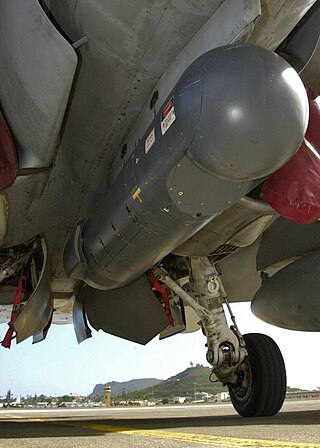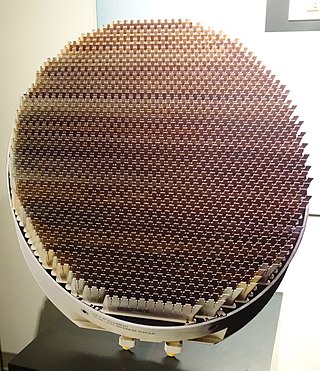Related Research Articles

The AGM-88 HARM is a tactical, air-to-surface anti-radiation missile designed to home in on electronic transmissions coming from surface-to-air radar systems. It was originally developed by Texas Instruments as a replacement for the AGM-45 Shrike and AGM-78 Standard ARM system. Production was later taken over by Raytheon Corporation when it purchased the defense production business of Texas Instruments.

The Northrop Grumman B-2 Spirit, also known as the Stealth Bomber, is an American heavy strategic bomber, featuring low-observable stealth technology designed to penetrate dense anti-aircraft defenses. A subsonic flying wing with a crew of two, the plane was designed by Northrop and produced from 1987 to 2000. The bomber can drop conventional and thermonuclear weapons, such as up to eighty 500-pound class (230 kg) Mk 82 JDAM GPS-guided bombs, or sixteen 2,400-pound (1,100 kg) B83 nuclear bombs. The B-2 is the only acknowledged in-service aircraft that can carry large air-to-surface standoff weapons in a stealth configuration.

The General Dynamics F-16 Fighting Falcon is an American single-engine supersonic multirole fighter aircraft originally developed by General Dynamics for the United States Air Force (USAF). Designed as an air superiority day fighter, it evolved into a successful all-weather multirole aircraft with over 4,600 built since 1976. Although no longer purchased by the U.S. Air Force, improved versions are being built for export. In 1993, General Dynamics sold its aircraft manufacturing business to the Lockheed Corporation, which became part of Lockheed Martin after a 1995 merger with Martin Marietta.

The McDonnell Douglas F-15 Eagle is an American twin-engine, all-weather tactical fighter aircraft designed by McDonnell Douglas. Following reviews of proposals, the United States Air Force (USAF) selected McDonnell Douglas's design in 1969 to meet the service's need for a dedicated air superiority fighter. The Eagle first flew in July 1972, and entered service in 1976. It is among the most successful modern fighters, with over 100 victories and no losses in aerial combat, with the majority of the kills by the Israeli Air Force.

Northrop Grumman Corporation is an American multinational aerospace and defense technology company. With 95,000 employees and an annual revenue in excess of $30 billion, it is one of the world's largest weapons manufacturers and military technology providers. The firm ranked No. 101 on the 2022 Fortune 500 list of America's largest corporations.

The Northrop F-20 Tigershark is a light fighter, designed and built by Northrop. Its development began in 1975 as a further evolution of Northrop's F-5E Tiger II, featuring a new engine that greatly improved overall performance, and a modern avionics suite including a powerful and flexible radar. Compared with the F-5E, the F-20 was much faster, gained beyond-visual-range air-to-air capability, and had a full suite of air-to-ground modes capable of utilizing most U.S. weapons. With these improved capabilities, the F-20 became competitive with contemporary fighter designs such as the General Dynamics F-16 Fighting Falcon, but was much less expensive to purchase and operate.

The McDonnell DouglasF-15E Strike Eagle is an American all-weather multirole strike fighter derived from the McDonnell Douglas F-15 Eagle. The F-15E was designed in the 1980s for long-range, high-speed interdiction without relying on escort or electronic-warfare aircraft. United States Air Force (USAF) F-15E Strike Eagles can be generally distinguished from other US Eagle variants by darker aircraft camouflage, conformal fuel tanks (CFTs) mounted along the engine intake ramps and a tandem-seat cockpit.

The Northrop/McDonnell Douglas YF-23 is an American single-seat, twin-engine, supersonic stealth fighter aircraft technology demonstrator designed for the United States Air Force (USAF). The design was a finalist in the USAF's Advanced Tactical Fighter (ATF) demonstration/validation competition, battling the Lockheed YF-22 for the full-scale development contract. Two YF-23 prototypes were built.
The Northrop Grumman E-10 MC2A was planned as a multi-role military aircraft to replace the Boeing 707-based E-3 Sentry and E-8 Joint STARS, the Boeing 747-based E-4B, and the RC-135 Rivet Joint aircraft in US military service. The E-10 was based on the Boeing 767-400ER commercial airplane.

An active electronically scanned array (AESA) is a type of phased array antenna, which is a computer-controlled antenna array in which the beam of radio waves can be electronically steered to point in different directions without moving the antenna. In the AESA, each antenna element is connected to a small solid-state transmit/receive module (TRM) under the control of a computer, which performs the functions of a transmitter and/or receiver for the antenna. This contrasts with a passive electronically scanned array (PESA), in which all the antenna elements are connected to a single transmitter and/or receiver through phase shifters under the control of the computer. AESA's main use is in radar, and these are known as active phased array radar (APAR).

The AN/AAQ-28(V) Litening targeting pod is an advanced precision targeting pod system currently operational with a wide variety of aircraft worldwide. The research and development of the Litening was first undertaken by Rafael Advanced Defense Systems' Missiles Division in Israel, with subsequent completion of Litening I for use in the Israeli Air Force.

The United States Air Force (USAF), four of its NATO partners, and the Pakistan Air Force (PAF), a major non-NATO US ally, are the primary operators of General Dynamics F-16 Fighting Falcon. With the evolution of sales under Foreign Military Sales (FMS) contracts, many other air forces have also acquired F-16s. Most nations that have bought F-16s continue to use them as of 2010.

The AN/APG-66 radar is a solid state medium range pulse-Doppler planar array radar originally designed by the Westinghouse Electric Corporation for use in early generations of the F-16 Fighting Falcon; later variants use the AN/APG-68 or the AN/APG-83. This radar was employed in all domestic and export versions of the F-16 A/B models throughout the production. Subsequent upgrades have been installed in many varying aircraft types, including the U.S. Customs and Border Protection's C-550 Cessna Citation, US Navy P-3 Orion, and Piper PA-42 Cheyenne II's, as well as the Small Aerostat Surveillance System (SASS). Primary air-combat mode is look-down. In that mode, the AN/APG-66 can detect a fighter-size plane at a range of 34.5 Nautical miles. Four modes are available in air-to-air combat. In dogfight mode, the radar scans a 20 degrees x 20 degrees field. In high-g maneuvers, it scans a 40 degrees x10 degrees pattern. The radar system consists of the following line-replaceable units:

The AN/APG-63 and AN/APG-70 are a family of all-weather multimode radar systems designed by Hughes Aircraft for the F-15 Eagle air superiority fighter. These X band pulse-Doppler radar systems are designed for both air-air and air-ground missions; they are able to look up at high-flying targets and down at low-flying targets without being confused by ground clutter. The systems can detect and track aircraft and small high-speed targets at distances beyond visual range down to close range, and at altitudes down to treetop level. The radar feeds target information into the aircraft's central computer for effective weapons delivery. For close-in dogfights, the radar automatically acquires enemy aircraft and projects this information onto the cockpit head-up display. The name is assigned from the Army Navy Joint Electronics Type Designation System.

The AN/APG-68 radar is a long range Pulse-doppler radar designed by Westinghouse to replace AN/APG-66 radar in the F-16 Fighting Falcon. After years of Service, AN/APG-68 radar currently being replaced on US Air Force F-16C/D Block 40/42 and 50/52 by the latest generation AN/APG-83 AESA radar.

The AN/APG-77 is a multifunction low probability of intercept radar installed on the F-22 Raptor fighter aircraft. The radar was designed and initially built by Westinghouse and Texas Instruments, and production continued with their respective successors Northrop Grumman and Raytheon after acquisition.
The AN/APG-80 is an Active Electronically Scanned Array (AESA) system designed and manufactured by Northrop Grumman for use on the Lockheed Martin F-16 Fighting Falcon fighter aircraft. It was originally designed to be included on the F-16C/D Block 60 Desert Falcon aircraft ordered by the United Arab Emirates, subsequently reclassified as the F-16E/F Block 60 Desert Falcons; first deliveries were made in 2003.

The AN/APG-81 is an active electronically scanned array (AESA) fire-control radar system designed by Northrop Grumman Electronic Systems for the Lockheed Martin F-35 Lightning II.

A large number of variants of the General Dynamics F-16 Fighting Falcon have been produced by General Dynamics, Lockheed Martin, and various licensed manufacturers. The details of the F-16 variants, along with major modification programs and derivative designs significantly influenced by the F-16, are described below.
References
- ↑ Corporation, Northrop Grumman. "Northrop Grumman's Scalable Agile Beam Radar (SABR) to Help Extend Viability of U.S. Air Force F-16s Beyond 2025". PR Newswire. Retrieved 7 February 2019.
- ↑ "Lockheed Martin Selects Northrop Grumman's Scalable Agile Beam Radar (SABR) for the F-16 AESA Radar Upgrade Program.". 31 July 2013. Retrieved 20 February 2017.
- ↑ "APG-83 Scalable Agile Beam Radar (SABR) AESA for the F-16 and Legacy Aircraft". Northrop Grumman. Archived from the original on 17 March 2015. Retrieved 7 February 2019.
- ↑ "Northrop Grumman Scalable Agile Beam Radar (SABR)".
- ↑ "United States Air Force Selects the Northrop Grumman APG-83 SABR for F-16 AESA Radar Upgrade". Northrop Grumman Newsroom. Retrieved 7 February 2019.
- ↑ Donald, David. "U.S. Air Force Orders AESA Radar for F-16s". Aviation International News. Retrieved 18 August 2021.
- ↑ "Singapore - F-16 Block 52 Upgrade | Defense Security Cooperation Agency". www.dsca.mil. Retrieved 18 August 2021.
- ↑ "Trade Registers". armstrade.sipri.org. Retrieved 18 August 2021.
- ↑ Julie Songer (13 August 2018). "Northrop Grumman Performs Successful SABR Fit-Check on F/A-18C Fighter at Marine Corps Air Station Miramar | Northrop Grumman". News.northropgrumman.com. Retrieved 7 February 2019.
- ↑ Peck, Michael (8 August 2017). "B-1 to get new radar". C4ISRNET. Retrieved 7 February 2019.
- ↑ "Northrop Grumman Corporation - News Releases". Globenewswire.com. Archived from the original on 12 May 2015. Retrieved 7 August 2015.
- ↑ "Scalable Agile Beam Radar - Global Strike (SABR-GS) AESA for the B-1B". Northrop Grumman. Retrieved 7 February 2019.
- ↑ Tyler Rogoway. Northrop Grumman Is Vying To Give B-52 Bomber A Game-Changing New Radar. The War Zone (Feb 26, 2019)
- ↑ Vivienne Machi. Raytheon Wins Contract to Provide New AESA Radars to B-52 Aircraft. Defense Daily (July 11, 2019)
- ↑ "ADEX 2021: KAI reveals more details about FA-50 upgrade plans".
- ↑ "South Korea Launches KF-16 Fighter Upgrades Upended".
- ↑ Hunter, Jamie. "USAF launches huge upgrade program for its F-16s". Skies Magazine. Retrieved 25 September 2022.
- ↑ Leone, Dario. "USAF to Upgrade 608 F-16 fighter jets to V variant in Viper Fleet largest Modification Work in History". The Aviation Geek Club. Retrieved 25 September 2022.